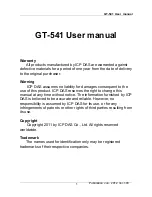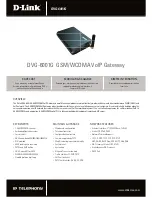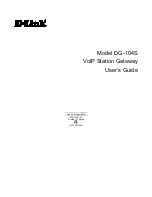
Chapter 5
Configuration Using the Web-based Utility
34
24/48-Port 10/100 + 4-Port Gigabit Smart Switch with Resilient Clustering Technology and PoE
The assignment of network traffic to a particular
hardware queue
The assignment of internal resources
Traffic shaping
The terms Class of Service (CoS) and QoS are used in the
following context:
CoS provides varying Layer 2 traffic services. CoS
refers to classifying traffic into traffic classes, where
each class is handled as an aggregate whole, with no
per-flow settings. CoS is usually related to the 802.1p
service that classifies flows according to their Layer 2
priority, as set in the VLAN header.
QoS refers to Layer 2 traffic and above. QoS handles
per-flow settings, even within a single traffic class.
The QoS configuration options are
CoS Settings
,
Queue
Settings
,
DSCP Settings
, and
Basic Mode
.
QoS > CoS Settings
The
CoS Settings
screen is used to enable or disable CoS.
QoS > CoS Settings
CoS Settings
QoS Mode
Indicates if QoS is enabled. The possible
values are:
Disable
Disables QoS.
Basic
Enables QoS. This is the default value.
Class of Service
Specifies the CoS priority tag values,
where
0
is the lowest and
7
is the highest.
Queue
Defines the traffic forwarding queue to which the
CoS priority is mapped. Four traffic priority queues are
supported.
Click
Restore Defaults
to restore the device factory
defaults for mapping CoS values to a forwarding queue.
•
•
•
•
•
•
•
CoS Default
Unit No.
The unit to which the CoS configuration applies.
Default CoS
Determines the default CoS value for
incoming packets for which a VLAN tag is not defined. The
possible field values are
0
-
7
. The default CoS is
0
.
LAG
The LAG to which the port belongs, if relevant. If the
port is a member of a LAG, the LAG settings override the
port settings.
Click
Save Settings
to save the changes, or
Cancel
Changes
to cancel the changes.
QoS > Queue Settings
The
Queue Settings
screen is used to define the QoS queue
forwarding types.
QoS > Queue Settings
Strict Priority
Indicates that traffic scheduling for the
selected queue is based strictly on the queue priority.
WRR
Indicates that traffic scheduling for the selected
queue is based strictly on the WRR.
Queue
Displays the queue (1-4) for which the queue
settings are displayed.
WRR Weight
Displays the WRR weights to queues.
% of WRR Bandwidth
Displays the percentage of
bandwidth assigned to the queue. These values are fixed
and cannot be modified.
Click
Save Settings
to save the changes, or
Cancel
Changes
to cancel the changes.
















































